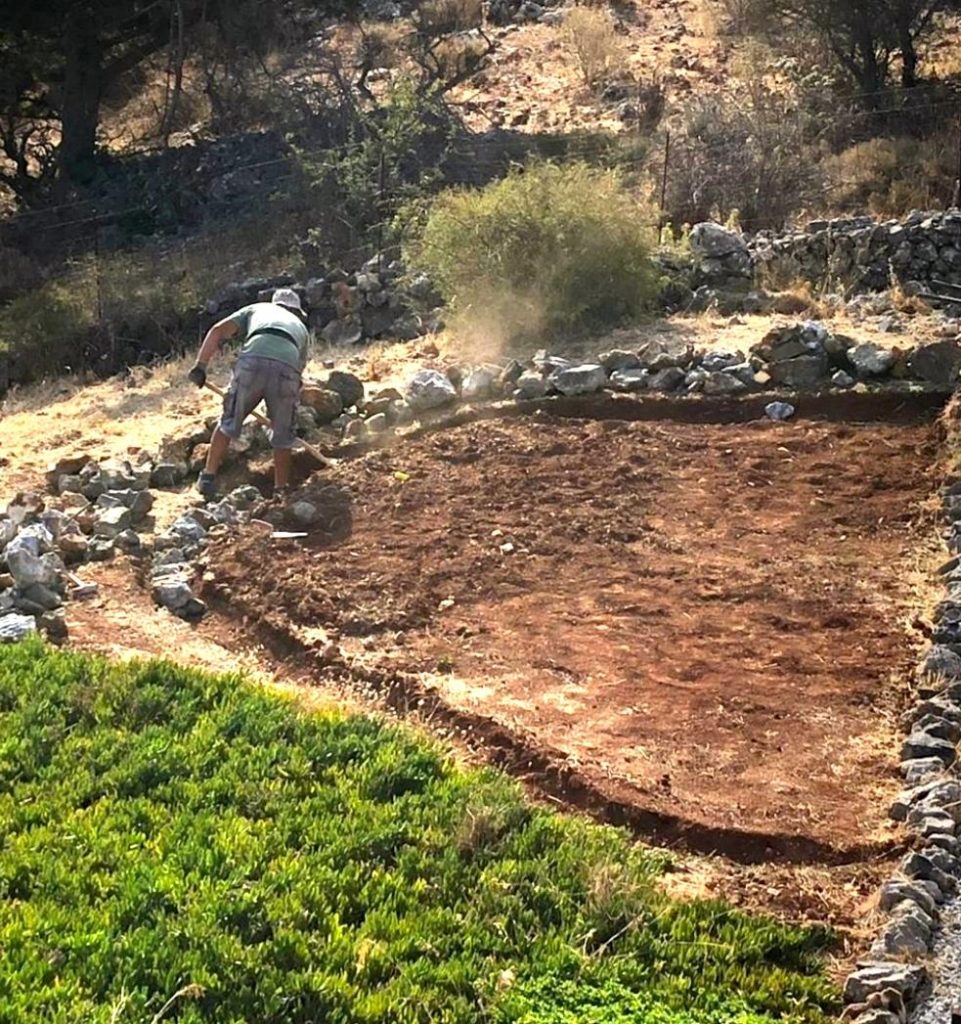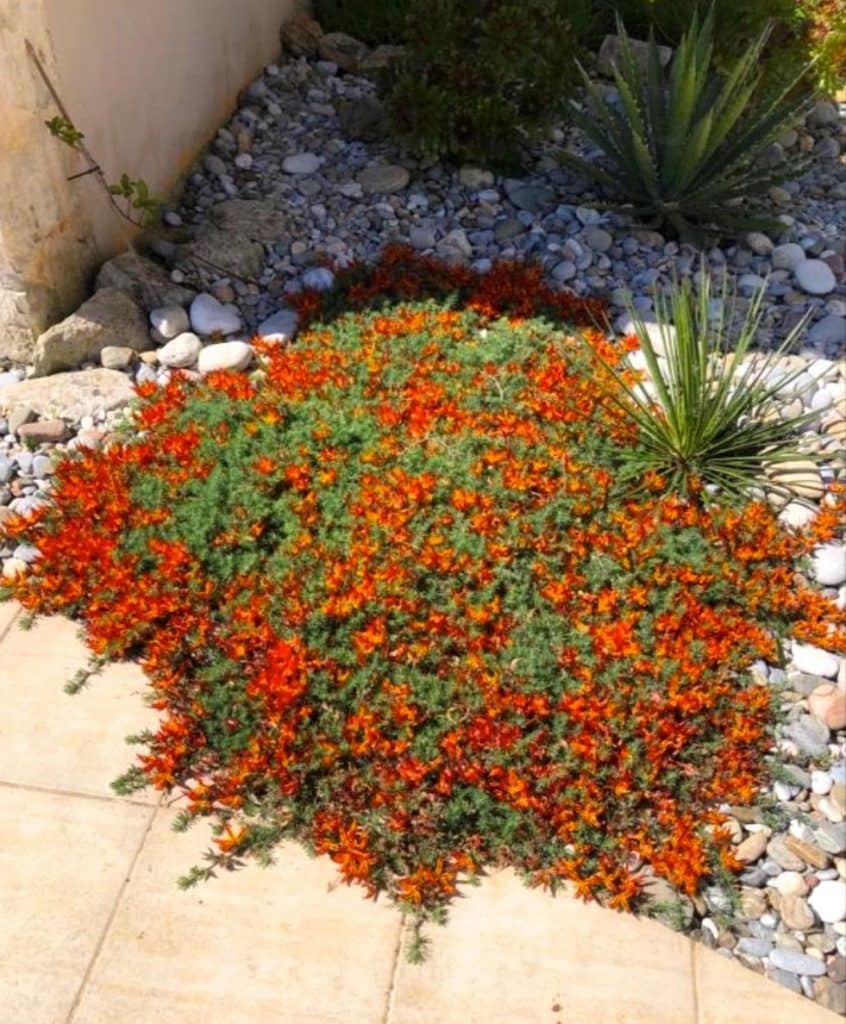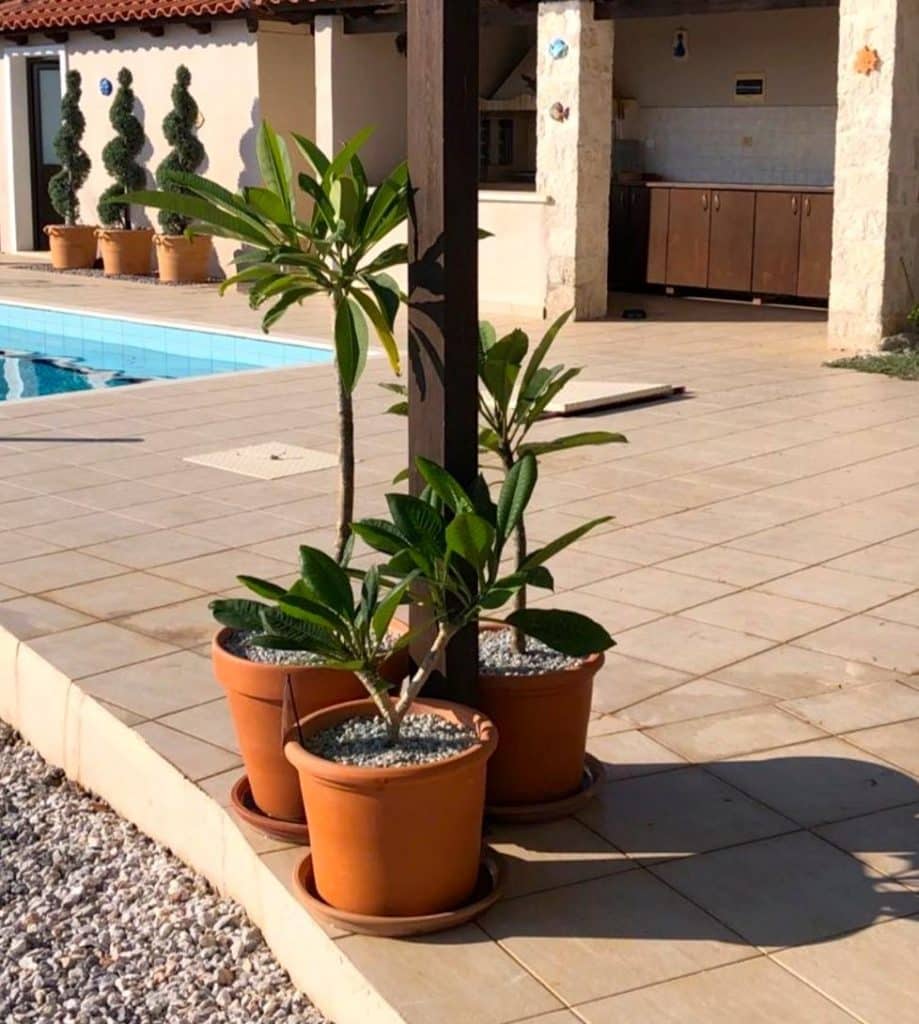Creating a cretan garden
In September 2019, Linda approached me wanting to finally create a garden at her home near the tiny Cretan village of Palailoni, Apokoronas, NW Crete. I was a little anxious as Manoj & Clive own the villa next door. However, when Linda spoke to them about it, they were keen to see how the garden developed. This is what we did.
First, some information on Crete’s climate
Crete straddles two climatic zones, the Mediterranean and the North African, mainly falling within the former. As such, the climate in Crete is primarily Mediterranean, the atmosphere can be quite humid, depending on the proximity to the sea, while winter is fairly mild. Snowfall is common in the mountains between November and May, but rare in the low-lying areas. While some mountain tops are snow-capped for most of the year, near the coast snow only stays on the ground for a few minutes or hours.
However, a truly exceptional cold snap swept the island in February 2004, during which period the whole island was blanketed with snow. During the Cretan summer, average temperatures reach the high 20s-low 30s Celsius (mid-80s to mid-90s Fahrenheit), with maxima touching the upper 30s-mid 40s.
Crete is the largest of the Greek islands. The island has an elongated shape: it spans 260 km (160 mi) from east to west, is 60 km (37 mi) at its widest point, and narrows to as little as 12 km (7.5 mi) close to Lerapetra.
Hard landscaping
The house looks out to the NE over the sea of Crete, with the Drapanos peninsula to the north, and Mount Ida, the highest mountain on Crete (2,456 m (8,058 ft) and the birthplace of Zeus to the east.
We decided to construct 4 patio areas on the top of the rise close to the house and pool. A breakfast patio which is shaded in the morning and three sun patios.


Carving out the shape of the poolside patio in the heat of the Cretan sun
Poolside patio constructed using local stone. Some of the stone used was found around the property which the builders had left through excavations of the villa. On the left, a large planting border is being developed. Topsoil has been laid and weed suppressant matt has been put down.

Planting below the poolside patio. A good depth of gravel covers all the planting borders. This helps suppress weeds and prevents water evaporation. Here I have chosen to plant Agapanthus, Cistus creticus, Lavenders, and Gaura
How to plant?
It sounds like a simple question. How do I plant up a new garden? Here on Crete, we have to deal with the local flora, the searing summer temperatures, drought and bedrock. These important factors determine what we can plant how we can plant, when we can plant and what tools we use. The best solution was to plant into new soil and compost through horticultural membrane and gravel. This physical barrier suppresses weeds and significantly retains moisture in the ground, reducing our water use. An important decision, given our climate and the need to conserve water. A fork and spade a useless here on Crete. We use a pickaxe and mattock. The best time to plant is either when the rains start but it is not overly wet or in spring when the soil is workable. When planting, leave a swale around the plants for water to collect into and go directly to the roots. This is especially important for trees.
What to plant?
The poolside border is an attempt to reproduce an herbaceous border but using drought-tolerant plants for a Mediterranean climate

Freshly planted border. The three Cupressus sempervirens pyramidalis provide structure and height. I have added a selection of grasses, perennials and ground cover plants.
Plants
There is a complete list of all the plants used in the garden, however, in the picture below the following have been planted. Agapanthus nana, Dwarf white agapanthus, Tulbaghia violacea, Ruellia simplex, Oenothera speciosa, Pennisetum rubrum, Cupressus sempervirens, Plumbago auriculata, Cascabela thevetia, Lantana montevidensis, Red and white gaura.

The same herbaceous border now fully established in 2020. Plant growth in Crete is very quick.

Another view of the herbaceous border showing how full of colour it is. It also attracts wildlife and helps to create biodiversity.
Cactus corner
We had a small sun trap next to the BBQ area and we decided to plant this small space with cacti and succulents.

This is the cactus corner. At the front I chose to plant Lotus berthelotii which I understand is becoming quite rare in its natural habitat

The cactus corner in 2020. I have planted a variety of Agaves and succulents

The cactus corner in winter 2021. The plants have doubled in size.
Dry and endemic species garden
We thought it appropriate to plant a dry garden section that used drought-tolerant and endemic plants from Crete.

The plants in this border are drought tolerant. They will be watered initially to get them established. Once they do this, the irrigation will be stopped, and they then have to cope on their own. The only time they may get some water is when it is unusually hot for Crete and the plants look stressed.

This area is the pool patio area. The doors for the house lead directly out on this patio. I have planted 3 Plumeria in pots here. The scent of these is divine. Linda likes to potter in the garden. I potted up 3 Cupressus arizonica spirals for her. These are positioned outside the storeroom wall. Linda enjoys clipping and maintaining these.
Breakfast Patio

This is the breakfast patio which gets a little more shade and is a bit cooler. I have planted this area with hot colours.

The border around the breakfast area is a riot of hot colours.Bird of Paradise Strelizia reginae, Tithonia Mexican sunflower, Helianthus ‘Irish eyes’, Cyclamen coum, Gardenias, Salvia reggii, Cascabela thevetia…

Being cleared in the foreground is a thug of a plant commonly known as the Hottentot Fig. It grows quickly and will overtake everything in its path. It will also draw out precious water and nutrients in the soil. Grow this plant with caution.

This section of the garden is under development where I am creating a dry riverbed.
PLANT LIST
- Aeonium arboreum Zwartkop
- Agapanthus
- Agave americana
- Anisodontea Elegans Princess
- Ballota pseudo dictamnus
- Bulbine frutescens
- Cascabela thevetia
- Catananche caerulea
- Cistus creticus
- Convolvulus cneorum
- Convulvulus mauritanicus
- Cordyline australis Red Star
- Crithmum maritimum
- Crocosmia Lucifer
- Cupressus arizonica
- Cupressus sempervirens pyramidalis
- Cycas revoluta
- Ebenus cretica
- Echium candicans
- Gardenia lindheimeri
- Grevillea (variety unknown)
- Iris alba (edemic specie)
- Lantana Fruit Salad
- Lantana montevidensis
- Lantana Yellow Gold
- Laurus nobilis
- Lavandula angustifolia
- Lomelosia cretica
- Lotus berthelotii
- Oenothera speciosa
- Pennisetum alopecuroides Hameln
- Pennisetum rubrum
- Plumbago auriculata
- Plumeria
- Salvia rosmarinus Miss Jessopp’s Upright
- Salvia rosmarinus prostrates
- Rudbeckia fulgida goldtrum
- Ruellia simplex
- Salvia microphylla Royal Bumble
- Salvia nemerosa Caradonna
- Salvia x jamensis Hot Lips
- Stachys creticus
- Strelitzia reginae
- Teucrium frutican Agadir
- Teucrium fruticans
- Thymus serpyllum
- Thymus vulgaris
- Tithonia rotundifolia
- Tithonia Yellow Torch
- Tulbaghia violacea
- Verbena bonariensis
- Yucca Colour Guard

Andrew Lunt and his partner live full time in on the Greek island of Crete.
Having studied RHS Level 2 Andrew has now set up business in Crete developing and maintaining gardens for private clients. Andrew can be contacted on
[email protected]
All photos courtesy of Andrew Lunt



